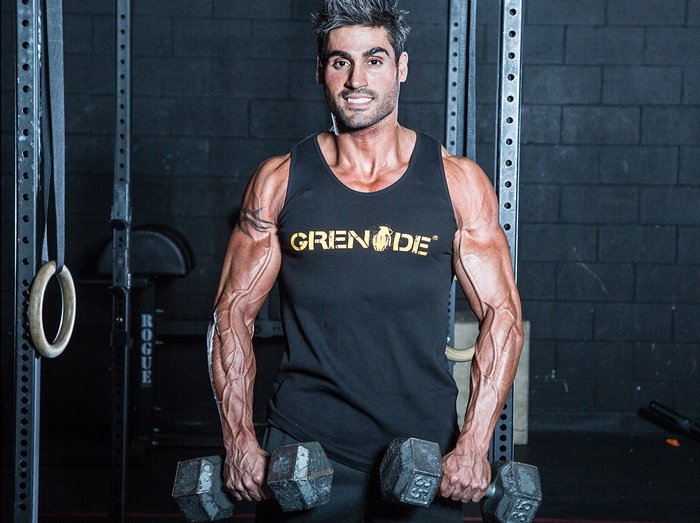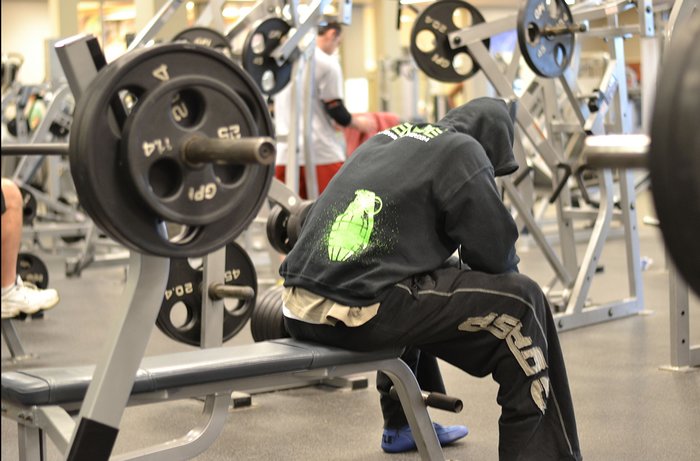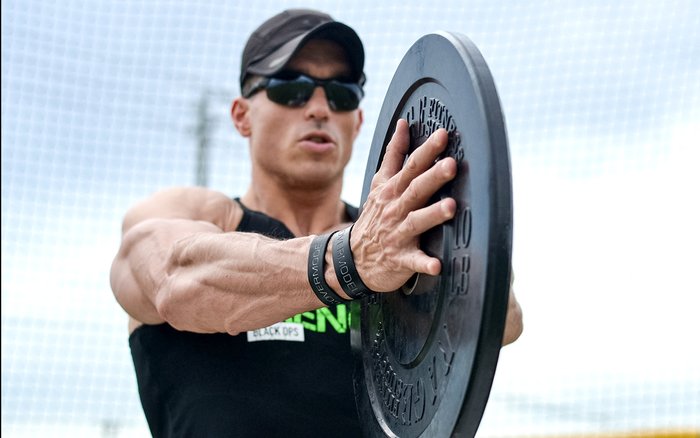This may sound like a bold assertion, but the five training tips you're about to read may cause you to shelve a lot of what you're currently doing in the gym. Yep, they're that insightful and that novel. And when applied correctly, they can help you make gains for many years to come.
Helping us elaborate on the five points are Melih Cologlu and Vinny Russo, Team Grenade physique athletes who've paid their dues in the gym and agreed to lend their personal perspective.
1. Start Your Workouts With The Exercises You Hate The Most
Most people have a few favorite exercises for each body part, and they're more likely to do those movements religiously in their workouts. Difficult, complex, or challenging exercises that are just plain hard to perform are often missing from these workouts, because they're the ones people typically hate most.
As an example, few beginners enjoy leg day, and the one exercise they steer clear of the most is the squat. Leg extensions, on the other hand, well, they aren't so bad. But which one delivers more bang for your buck? That's easy: multijoint, free-weight exercises like the squat have been proven to be superior to single-joint moves and machine work. Multijoint moves have been linked to a greater release of muscle-building hormones like testosterone and growth hormone. Moreover, if you've avoided them until now, your muscles are likely to respond to a growth spurt.
Over time, you'll learn that the most difficult movements are actually the ones that deliver the best results. Instead of avoiding them, include them regularly in your workouts, and do them first before fatigue sets in so you can use a really challenging weight.

If you find squats to be difficult, that probably means they'll do you the most good.
2. Stop Doing The Same Thing Over And Over Again
"I still see many trainees using the same sets and reps, performing the same exercises day in and day out," says Grenade athlete Melih Cologlu. "That doesn't bode well for your body, which requires change for further adaptation."
In the presence of good nutrition, a novel training stimulus forces the muscle fibers to rebuild themselves and grow stronger and thicker than before. But the impact of the stimulus begins to fade over time as the body adapts, so you have to continue increasing the overload in some way or you simply won't make any further adaptations. You can add more weight, do more reps, or decrease your rest intervals to continue making further gains.
Changing up your rep targets and intensity techniques—like using forced reps, partial reps, or negatives, and others—can also introduce variety and novelty into your workouts, but these techniques should be included in a well thought-out strategy rather than just randomly applied.
"What's worked for me is alternating between low-rep weeks and high-rep weeks, making changes to all those variables listed," says Cologlu. "If you hit a plateau, I also recommend rest-pause training, which has helped me break through plateaus. Another favorite is variable-resistance training using bands or chains."
"Making strategic changes to your workouts keeps plateauing at bay," agrees Grenade's Vinny Russo. "Once you get comfortable, you tend to stay there. This limits your physical potential, because you're no longer progressing. Get out of that comfort zone and push your limits. Once you become accustomed to that style of training, manipulate another variable to keep making it a challenge!"
3. Don't Make Every Set As Hard As Possible
Hardcore, dedicated lifters often use advanced training techniques to take every set well past muscle failure. I know I did; when I was in my 30s, my training partner and I did forced reps on every single set. We were determined to push as hard as possible.
I now know that was a mistake. An eight-week Australian study that found that doing one of four sets of bench presses to failure produced double the strength gains compared to lifters who didn't take any of their sets to failure.[1] But in a follow-up study, the researchers found that doing more than one set to failure on the bench offered no additional strength gains.[2]
When the two studies were compared, the strength gains reported in the group that took one set to failure were more impressive than the gains in the group that took multiple sets to failure. A possible reason? Taking just one set to failure may provide enough of a training stimulus without the risk of overreaching, which may occur when too many sets are taken to failure.

Taking too many sets to failure can, over time, result in a decrease in growth-inducing hormones.
Although training to failure can stoke muscle growth, there is evidence to suggest it may also increases the potential for overtraining and psychological burnout.[3,4] Additionally, training to failure over 16 weeks has been shown to reduce levels of growth-inducing hormones, suggesting subjects may have been overtrained.[5]
Further suggesting that training to failure plays a lesser role in the hypertrophic response is a study that noted that training to failure with light weight did not produce marked strength gains (meaning that failure itself wasn't the most critical factor).[6] In fact, increasing the resistance of the movement recruits more motor units and is correlated with gains in strength and hypertrophy.[6,7]
Training intensity (average weight lifted per day, week, etc.) and relative intensity (percent of your one-rep max) are more critical to making gains in strength and power, especially among experienced trainers.[8-10] Using heavier weights and not consistently training to failure provides adequate stimulus, especially with regard to strength development.[8]

Training with relatively heavy weights does more for strength and hypertrophy than training to failure.
4. Expand Your Exercise Repertoire
Identifying new movements you'd like to try isn't difficult; in fact, it's only a click away on Bodybuilding.com. We constantly feature unusual exercise variations, such as new twists on triceps and back workouts, from our roster of athletes and experts.
Besides trying movements that are new to you, do existing ones you already like with different kinds of equipment, or a change in grip, stance, or body position. Making even small-scale changes works the target musculature in slightly different ways than it's used to, allowing you to more thoroughly work the muscle.
"I usually perform the big three movements [bench press, deadlift, and squat] in the traditional manner, but I constantly vary most of my other exercises, trying to isolate the same muscle groups by hitting them with different exercises and from different angles," says Cologlu.

Learn new movements, which can have big-time effects on re-igniting muscle growth.
5. Train For The Pump—But Only At The End Of Your Workout
Ever since Arnold Schwarzenegger famously (and colorfully) stated the intense joy of achieving a great pump, bodybuilders have sought it like the holy grail in their training. But make no mistake: The pump is a result of higher-rep training, especially when combined with advanced training techniques that thoroughly exhaust a muscle. That's best left for the end of your workout. The fact is, you don't want to use that style of training to start your body-part training.
Instead, start with heavier weights for low-to-moderate reps. Done early in your workouts, when fatigue hasn't yet set in, this protocol can induce muscle growth via both mechanical tension and muscle damage. Those mechanisms are far less stimulated when using lighter weights than when training for a muscle pump. However, higher reps are superior for driving fluids into the muscle, which increases metabolic stress. All three mechanisms are believed to contribute to muscle growth.
Bottom line: If you're train only for a pump, you're shortchanging the other two mechanisms linked to muscle growth. Save the high reps associated with the pump for the tail end of your body-part session.
References
- Drinkwater, E. J., Lawton, T. W., Lindsell, R. P., Pyne, D. B., Hunt, P. H., & McKenna, M. J. (2004). Repetition failure is a key determinant of strength development in resistance training. Medicine & Science in Sports & Exercise, 36(5), S53.
- Drinkwater, E. J., Lawton, T. W., Lindsell, R. P., Pyne, D. B., Hunt, P. H., & McKenna, M. J. (2005). Training leading to repetition failure enhances bench press strength gains in elite junior athletes. The Journal of Strength & Conditioning Research, 19(2), 382-388.
- Schoenfeld, B. J. (2010). The mechanisms of muscle hypertrophy and their application to resistance training. The Journal of Strength & Conditioning Research, 24(10), 2857-2872.
- Fry, A. C., & Kraemer, W. J. (1997). Resistance exercise overtraining and overreaching. Sports Medicine, 23(2), 106-129.
- Izquierdo, M., Ibanez, J., González-Badillo, J. J., Häkkinen, K., Ratamess, N. A., Kraemer, W. J., ... & Gorostiaga, E. M. (2006). Differential effects of strength training leading to failure versus not to failure on hormonal responses, strength, and muscle power gains. Journal of Applied Physiology, 100(5), 1647-1656.
- Atha, J. (1981). Strengthening muscle. Exercise and Sport Sciences Reviews, 9(1), 1-74.
- Dudley, G. A., Tesch, P. A., Miller, B. J., & Buchanan, P. (1991). Importance of eccentric actions in performance adaptations to resistance training. Aviation, Space, and Environmental Medicine, 62(6), 543-550.
- Stone, M. H., Chandler, T. J., Conley, M. S., Kramer, J. B., & Stone, M. E. (1996). Training to Muscular Failure: Is It Necessary? Strength & Conditioning Journal, 18(3), 44-48.
- Stone, M. H., & O'Bryant, H. S. (1987). Weight Training: A Scientific Approach. Burgess International Group.
- Kramer, J.B., Stone, M.H., O'Bryant, H.S., Nieman, D.C., Conley, M.S., Johnson, R.L. Honeycutt, D.R. and Hoke, T.P. Effects of three different weight training programs on leg and hip strength (1RM Squat) and vertical jump. Presentation at the NSCA National Meeting, Las Vegas, June, 1993.

